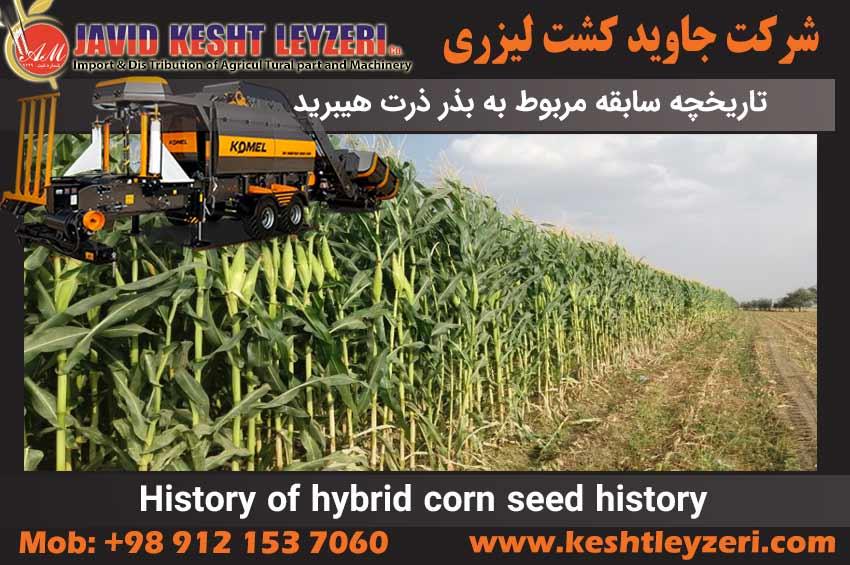
History of hybrid corn seed history
javid keshtleyzeri Co.ltd
Thousands of years of experience and knowledge in the field of agriculture give farmers the knowledge that the combination between different plant species can lead to the creation of a new generation with greater strength. Traces of the co-planting of two different types of corn in different regions of the Americas, archeology shows, suggests that cross-pollination can help improve crops. All this traditional knowledge was confirmed and developed by scientific experiments in the 18th century. In this article, the results of these tests and their effect on the improvement of corn hybrid seeds are examined in detail.
Scientific studies have shown that corn plants produced from cross-pollinated plants have more advantages than self-pollinated plants. One of the researchers of this topic in the last 18th century was Gregor Mendel. In his research on pea plants, he investigated inheritance and digital inheritance and showed that plants resulting from the crossing of two different lines lead to stronger growth than self-pollinated plants.
It is an idea championed by Charles Darwin, that plants that are less self-pollinating, less resistant to pests, and less productive than hybrid plants. His work had a great influence on many scientists. For example, in the 1880s, William Beale studied pollination control as a way to reduce the negative effects of selfing in corn. But it should be remembered that DNA had not yet been discovered when Mendel and Darwin were working. Mendel only researched the inheritance patterns of traits. The term allele or gene was not used at that time, and many changes in our understanding of heredity and genetics occurred in the late 18th and early 19th centuries.
Hybrid corn seed in the 19th century
During this period, corn farmers faced a big challenge. They tried to increase the corn yield by saving their best seeds and using them as seed. But they could not maintain the improved quality and performance that they sometimes achieved. In fact, they were facing a problem. How can they maximize the effects of gene transfer to increase corn yield?
Creating varieties of corn with desired characteristics requires understanding the principles of heredity and knowledge about alleles (different genetic groups). In the early 20th century, George Scholl used Mendel's theory to understand species change and divergence as well as disease outbreaks in corn. He conducted experiments that led to geographical changes in corn samples. In 1908, George Scholl was the first person to formally describe the concept of heterozygosity. This idea changed the way of trying to obtain the desired varieties of corn. Therefore, corn growers gradually looked for the best hybrid corn combinations from existing corn lines, as suggested by Scholl.
What are single cross hybrid seeds?
Hybrid seeds of two simple vessels are a type of seed that are produced by inoculation of two parent plants with different genetics. The hybrid seeds of two simple vessels are planted by the recovery generation box and unlike the first harvest, they will all have the same traits. The meaning of "two veins" is also related to the presence of two colored lines in the leaves of the seeds. These seeds contain a combination of parental characteristics that appear in new and diverse forms in the seeds.
In a paper published in 1909, Scholl introduced methods for breeding maize with the aim of producing strong and uniform hybrids. At that time, due to the difficulty and high cost of preparing hybrid seeds, this idea was not given enough attention. Maize lines, which were necessary for the production of F1 hybrids, were not sufficiently strong and pure. These lines had relatively poor performance and produced few seeds. Also, there was their sensitivity to pests. But the biggest challenge for these lines was that they did not have the ability to compete with weeds. It should be noted that at the beginning of the 20th century, the use of pesticides to control pests and weeds was not yet widespread. For this reason, hybrid seed production was very complicated and expensive.
What are double cross hybrid seeds?
Double Cross Hybrid Seeds were first developed in 1937 at the Ladoux Seed Company by Francois Kensel and Van Rien. These seeds are obtained from round inoculation of two different species. In other words, their father is one species and their mother is another species. This beekeeping method is used to inoculate natural plants or by using bees' iodine homolog. The double genetic combination improves desired traits such as fast growth, high yield percentage, resistance to diseases and different environmental conditions and new hybrid structures. Also, double-round hybrid seeds have better fertility due to the use of soil products in the production and are added, and are usually suitable for semi-arid Arctic fields along with agricultural recommendations.
However, in 1918, David F. Jones was able to develop another type of hybrid. He created the double hybrid or F2, which is made from crossing the hybrids of the first period or F1. The fact is that these double hybrids are formed by crossing four different lines. Jones' tests showed that the yield of double hybrids was slightly lower than that of first-period hybrids, but other desirable traits were preserved.
Double hybrids were an important turning point in the production of hybrid seeds. Because they knock down weeds stronger than F1 hybrids and have a better appearance than inbred lines. For this reason, it was easier and cheaper to produce double hybrid seeds at that time. Double hybrids were commercially available, for example, by 1921.
Hybrid cultivars provide better yield along with agricultural technology
Hybrid varieties of corn - simple and double cross - have many advantages. Plant breeders usually create cultivars with specific traits. These cultivars may be fast growing, show better tolerance to drought stress or high resistance to pests. For example, in addition to the main desired traits, hybrid corn seeds have a much higher yield, and farms that use these cultivars have more uniform genetics.
The existence of uniform genetics means that plants usually have different heights and have different times for flowering, pollen production and harvest, and even have different seeds. The use of hybrid corn seeds makes agricultural technologies such as mechanical harvesting easier. This reduces the need for labor and reduces product losses, resulting in greater productivity. Since the 1940s, many changes have been made in the field of corn breeding in cultivar planning. These changes have led to increased yield and reduced production costs, including increased use of fertilizers and herbicides, increased irrigation efficiency in dry areas, and greater use of agricultural machinery. Improvements in corn production over the past few decades have led to an average increase in its yield.
Single-cross hybrids have less genetic variation than double-vein hybrids, as a result, these hybrids show higher yields and many desirable traits such as pest resistance in all plants. By better controlling weeds using herbicides, plant breeders have been able to grow inbred lines with less competition from weeds. Since the 1960s, the use of simple crossbred corn hybrids, which have higher yields and are easier and faster to develop, has become a common system.
What is the disadvantage of hybrid seeds?
The weakness of hybrid seeds is actually related to the genetic weaknesses that may exist in these seeds. Hybrid seeds are created when two parents with different genotypes are intelligently combined to obtain desirable traits in the next generation.
But one of the weaknesses of these seeds is that they usually have more weaknesses against stressful living conditions or harsh environmental conditions. For example, these seeds may be more sensitive to diseases, pests, drought or cold.
In general, these seeds are created for use in artificial cultivation conditions and maximum exploitation, and in the occurrence of problems in natural environments, they may have poor performance. But under the right conditions, the application of these seeds is good for increasing yield and resistance to diseases and environmental conditions.
In the 20th century, increased performance was associated with genetic uniformity. Genetic uniformity leads to higher yield, greater resistance to pests and plants of similar height and the ability to use mechanization. But at the same time, genetic uniformity may have costs such as vulnerability.
Because if a pest can exploit an unexpected weakness in a plant, all plants with genetic uniformity are at risk. For example, in 1970-1971, a disease outbreak destroyed 15 percent of the corn crop in the United States, costing more than $1 billion. The cause of the damage caused by this disease was a fungus known as southern corn leaf blight. The fungus had a rare natural mutation that infected more than 85 percent of the corn grown in the United States in the same years.
Corn hybrid seeds have many vulnerable genes. Although these genes are of great value in hybrid production, it is very costly to remove multiple male tassel or corolla flowers from mother plants. In corn, there are certain genes that cause male flowers to become sterile by triggering genetic processes. Therefore, seed producers no longer need to manually remove corolla or male tassel flowers. Instead, fertile seeds are produced by pollination of the paternal bases. In general, farmers can use these fertile seeds as seeds.
An epidemic crisis in the 1970s in the United States was related to the dangers of genetic population uniformity. Since then, efforts have been made to maintain genetic diversity in inbred plants, along with taking advantage of the homogeneity of different genetic populations. This issue has also reduced the time of arrival of new numbers. By having a large number of maize hybrid cultivars in a country, it is also possible to maintain genetic diversity at the farm level and even across the country, and concerns about the uniformity of the genetic population over a long period of time are addressed.
Conclusion of the discussion
In the early 20th century, the average corn yield in the United States was 1,350-2,000 kg/ha. But now, its average yield is more than 8 tons per hectare. This improvement in yield has occurred due to a better understanding of key maize traits. Researchers have learned how desirable traits, such as seed size and plant height, are passed down from generation to generation. They also found that hybrid plants have better performance and growth than conventional plants. The scientific efforts made by various researchers have caused great changes in agricultural science. With a better understanding of the potential of hybrids, researchers are researching the knowledge of corn success to combine inbred lines to obtain early, medium and late hybrid cultivars. Because hybrid seeds are more productive and also have less genetic diversity than conventional seeds, which cause more mechanization.
The discovery of the ability to produce potatoes in Qalamli led to the use of this technology in other crops as well. Other crops such as rice, barley and grain crops, as well as various ornamentals, are now using hybrids to enhance yield and uniformity.






